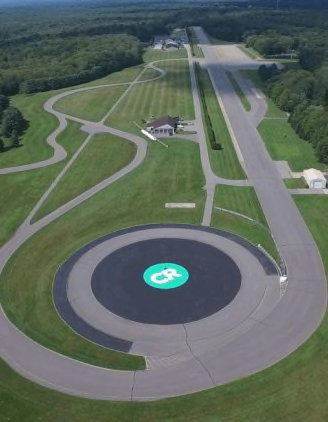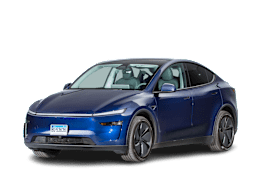The freshened Model Y SUV implements the same changes we saw in the updated Tesla Model 3 sedan, including a more compliant ride, acoustic glass for a quieter cabin, upgraded interior materials, and—in the mid-level Premium trim and up—an 8-inch touchscreen for rear passengers.
Although it’s not a full redesign, the moderately updated Model Y remains an important vehicle, as it has been far and away the bestselling EV in the U.S. due to its practical combination of size, driving range, and price. Like the previous Model Y, it still benefits from thrilling acceleration, sharp handling, a long driving range, comfortable front seats, and wonderfully unobstructed forward views.
Yet, the Model Y isn’t the easiest vehicle to live with. The ride has improved, but it was a low hurdle and it’s still quite firm. The new interior materials are slightly better, but the cabin retains its minimalist, almost stripped-down appearance. And even though the Model Y retains a turn signal stalk (the Model 3 relies on steering wheel buttons), most of the controls—including the slider-based gear selector, screen-based wiper and headlight controls, and the lack of a driver’s instrument screen—are maddening to use. Even the flush-mounted exterior door handles are extremely awkward, and will serve as a daily nuisance for owners.
After our testing was complete, we were torn as to how we felt about the revamped Model Y. “Stiff ride, abrupt regenerative braking at low speeds, too much reliance on the screen, wimpy air conditioning—these could be deal breakers,” said one of our testers. “But on the other hand, the car is very quick and the handling is super agile. Plus, it's efficient, has a long driving range, and it’s easy and quick to recharge.”
“I found the freshened Model Y to be a pretty nice package,” said another tester. “Yes, some of the controls are pretty infuriating and the ride isn't the best. But the powertrain, handling, and driver assistance capabilities are impressive.”
We bought a 2026 Tesla Model Y Long Range AWD for $52,380 (anonymously, as we do with every vehicle we test) for the purpose of this road test review. Our Model Y was assembled in Austin, Texas.
Driving experience
The base, rear-wheel-drive Model Y produces 295 hp and is available with both standard and long-range batteries. There’s also a Performance model with 456 hp. In the middle sits the Model Y we tested, which has 384 hp from dual electric motors, all-wheel drive, and the long range battery. It has lots of smooth forward thrust, and the all-wheel-drive system does a great job harnessing its zippiness, putting the power to all four tires with nary a chirp, even when punching the throttle. It sprinted from 0 to 60 mph in just 4.4 seconds, which is quite quick among similarly priced EVs, and 0.3-seconds speedier than the last Model Y we tested.
The tuning of the accelerator pedal and the regenerative braking system makes the car fairly easy to drive smoothly. That’s a good thing, because the driver is stuck with only two levels of fairly aggressive regen-braking, without the option for a coast mode. Most EVs offer more settings. While we found it fine most of the time out on the road, it’s annoying at parking-lot speeds because releasing pressure off the accelerator pedal can feel like the parking brake has been activated suddenly. This makes it difficult to not be abrupt when turning around or backing up in a parking lot or driveway.
We recorded 331 miles during our 70-mph highway-range test, which is on the longer side among current EVs, and exceeds the EPA’s 327-mile estimate for our test car. Home charging on a 240-volt circuit is speedy, with about 42 miles of range added per hour. At public DC fast-charging stations, including Tesla’s Supercharger network, the Model Y benefits from a 250 kilowatt max acceptance rate, which equates to about 15 miles of range gained per minute of charging.
The Model Y’s retuned suspension results in a more compliant ride than before, though broken pavement and highway expansion joints still hit hard and send choppy sensations into the cabin. Is it more comfortable than before? Yes. Is it actually “comfortable?” Not really. It’s no longer punishing, but it’s still quite firm. On the bright side, the taut suspension does a good job keeping the body from jostling back and forth when driving on undulating pavement. Handling remains crisp, with super-quick steering and minimal body roll. But while the steering feels sporty on a twisty road, its darty nature makes it rather annoying when trying to cruise straight down the highway. Any little steering-wheel movement causes a bigger reaction than with most vehicles.
Braking performance has seen a slight downgrade, likely due to the use of different tires, though the Model Y still turned in competitively short stopping distances during our tests on both dry and wet surfaces. The brake pedal has a fairly natural feel out on the road, making it easy for our testers to use.
Cabin comfort
As with the previous Model Y, the cabin has a minimalist, almost bare-bones look about it. But the materials have been upgraded, many of them to a much higher level than competitively priced EVs. There’s microsuede trim on all four doors, supple synthetic leather seating surfaces, and beautiful felt-lined bins.
The front seats do a great job of balancing long-distance comfort with lateral support. We’d give the Model Y an A-plus for its driving position if only the gauges were in front of the driver. (They are off to the right, in the center-mounted 15.4-inch infotainment touchscreen.) At least the lack of a driver’s instrument screen gives an unobstructed forward view. Our drivers also appreciated the plentiful headroom and lack of any intrusion with their right knee from the center console.
The rear seat is spacious, with good knee and headroom, and we like the new power-recline function. But although underleg support isn’t bad, the seat really isn’t all that comfortable. It has a flat shape with little form, and the seatback, in particular, has rather firm padding.
The ability to power-fold and raise the rear seats makes it easy to expand the cargo room. The Model Y also benefits from a usefully-sized front trunk, or “frunk,” in which we were able to fit an overnight duffle bag and a backpack, and there’s a handy underfloor well in the rear cargo area which can handle an overnight duffle bag and two backpacks.
Controls and usability
Unfortunately, like other Teslas, the Model Y’s controls are an ergonomic nightmare. Most interior tasks—including shifting gears, and adjusting the side mirrors, steering wheel, and dashboard air vents—are handled through the center infotainment screen. For example, the air vents are adjusted by dragging your fingers across the screen. At least the Model Y, unlike the Model 3, retains its turn signal stalk. But its “monostable” design (which means the lever always returns to center) comes with its own set of issues that make it frustrating to use at times.
It’s also annoying that neither Android Auto nor Apple CarPlay are compatible with any Tesla. Further, the Model Y’s flush exterior door handles remain frustrating to use. Pressing on one side to pop the lever out and then pulling on the other side to open the door requires an awkward and unnatural hand movement.
Active safety and driver assistance
Standard active safety and driver assistance features include automatic emergency braking with pedestrian detection, automatic emergency braking that operates at highway speeds, blind spot warning, rear cross traffic warning, lane departure warning, lane keeping assistance, adaptive cruise control, and automatic high beams. Tiny red LEDs at the base of the windshield pillars form Tesla’s token blind spot warning system (in addition to the existing display of surrounding vehicles on the center screen).
A rear seat belt-minder system comes standard on the Model Y, which alerts the driver if a rear passenger unbuckles their seat belt during the trip. It’s unfortunate that a rear occupant alert system, which can help prevent children and pets from suffering heatstroke or hypothermia if unintentionally left behind in the vehicle, isn’t available on the Model Y.























